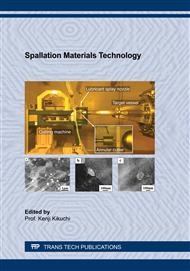[1]
H.S Chen, X.L. Wang, China's first pulsed neutron source, Nat. Mater. 15(2016) 689–691.
Google Scholar
[2]
M. Kawai, K. Kikuchi, H. Kurishita, et al., Fabrication of a tantalum-clad tungsten target for KENS, J. Nucl. Mater. 296 (2001) 312.
DOI: 10.1016/s0022-3115(01)00533-5
Google Scholar
[3]
D. Wilcox , P. Loveridge, T. Davenne, et al., Stress levels and failure modes of tantalum-clad tungsten targets at ISIS, J. Nucl. Mater. 506(2018)76-82.
DOI: 10.1016/j.jnucmat.2017.10.075
Google Scholar
[4]
L.K. Mansur, J.R. Haomes. Status of the Spallation Neutron Source with focus on target materials, J. Nucl. Mater . 356 (2006)1-15.
Google Scholar
[5]
Masatoshi Futakawa, Katsuhiro Haga, et al., Development of the Hg target in the J-PARC neutron source, Nuclear Instruments and Methods in Physics Research A, 600(2009)18-21.
DOI: 10.1016/j.nima.2008.11.103
Google Scholar
[6]
Lillard R.S, Pile D.L, Butt D.P, The corrosion of materials in water irradiated by 800 MeV, J. Nucl. Mater. 278(2000) 277-289.
DOI: 10.1016/s0022-3115(99)00248-2
Google Scholar
[7]
Alain R , Rosa J L, Corrosion behavior of niobium, tantalum and their alloys in hot hydrochloric and phosphoric acid solutions, International Journal of Refractory Metals & Hard Materials, 2000, 18:13.
DOI: 10.1016/s0263-4368(99)00034-7
Google Scholar
[8]
Berm´udez M D, Carri´on F J, Nicol´as G M, L´opez R, Erosion–corrosion of stainless steels, titanium, tantalum and zirconium, Wear, 2005,258:693.
DOI: 10.1016/j.wear.2004.09.023
Google Scholar
[9]
Rubinshtein A, Shneck , Danon A, Hayon J, Nathan S, Raveh A, Surface treatment of tantalum to improve its corrosion resistance, Materials Science and Engineering A, 2001,302:128.
DOI: 10.1016/s0921-5093(00)01364-2
Google Scholar
[10]
Hao J H, Chen Q, Xu Y C, et al. Flow field optimization and design for a Spallation Neutron Source target cooling system. Science China-Technological Science,2013, 56: 1370–1376.
DOI: 10.1007/s11431-013-5215-4
Google Scholar
[11]
Yu Q Z, Yin W, Liang T J. Calculation and analysis of DPA in the main components of CSNS target station, Acta Physica Sinica, 60(2001)052501.
DOI: 10.7498/aps.60.052501
Google Scholar
[12]
Xiao Y G, Liu T C, Liu J J,et al. Insight into the origin of lithium/nickel ions exchange in layered Li(NixMnyCoz)O2 cathode materials, Nano Energy, 2018, 49:77-85.
DOI: 10.1016/j.nanoen.2018.04.020
Google Scholar
[13]
Du Q, Liu X J, Fan H Y, et al. Reentrant glass transition leading to ultrastable metallic glass, Materials today, 2019, in press.
Google Scholar


